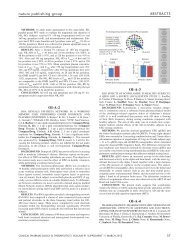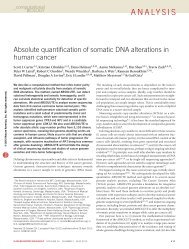open access: Nature Reviews: Key Advances in Medicine
open access: Nature Reviews: Key Advances in Medicine
open access: Nature Reviews: Key Advances in Medicine
You also want an ePaper? Increase the reach of your titles
YUMPU automatically turns print PDFs into web optimized ePapers that Google loves.
with respect to care-plan modification.<br />
Confirmation that this simple test helps<br />
to appropriately reclassify these patients<br />
is important. Further studies will facilitate<br />
our understand<strong>in</strong>g.<br />
Variability <strong>in</strong> outcomes between ethnic<br />
groups and with<strong>in</strong> CKD populations with<br />
similar diseases, has been another source<br />
of confusion over the past decades. Two<br />
important breakthroughs were made <strong>in</strong><br />
2011 with respect to genetic determ<strong>in</strong>ants<br />
of kidney disease. Firstly, the importance<br />
of the apolipoprote<strong>in</strong> L1 (APOL1) gene <strong>in</strong><br />
predict<strong>in</strong>g any form of progressive CKD <strong>in</strong><br />
African Americans, 2 will have a profound<br />
impact on cl<strong>in</strong>ical care (by suggest<strong>in</strong>g alternative<br />
treatment), familial donation strategies<br />
and our understand<strong>in</strong>g of progressive<br />
disease <strong>in</strong> this vulnerable population.<br />
Secondly, <strong>in</strong> another study, the f<strong>in</strong>d<strong>in</strong>g that<br />
soluble urok<strong>in</strong>ase-type plasm<strong>in</strong>ogen activator<br />
receptor (suPAR) is an important propagator<br />
of focal segmental glomerulosclerosis<br />
(FSGS), given its ability to activate podocyte<br />
β2 <strong>in</strong>tegr<strong>in</strong>, provides new <strong>in</strong>sights <strong>in</strong>to this<br />
condition. 3 In an elegant set of experiments,<br />
Wei et al. demonstrated the importance of<br />
elevated levels of suPAR <strong>in</strong> patients with<br />
FSGS, and found that lower<strong>in</strong>g of suPAR<br />
levels with plasmapheresis led to remission<br />
of disease. 3 Us<strong>in</strong>g a series of mouse models,<br />
Wei and collaborators clearly identified a<br />
relationship between suPAR and podocyte<br />
damage. Although the reason for the elevation<br />
<strong>in</strong> suPAR levels rema<strong>in</strong>s to be determ<strong>in</strong>ed,<br />
the fact that not all patients with<br />
FSGS have high levels of this prote<strong>in</strong> further<br />
confirms that FSGS is a response to <strong>in</strong>jury<br />
rather than a specific disease. Improv<strong>in</strong>g<br />
diagnostics and identify<strong>in</strong>g new therapies<br />
based on a better understand<strong>in</strong>g of the<br />
pathobiology is becom<strong>in</strong>g possible with<br />
discoveries such as those described above.<br />
‘‘ Overall, 2011 was an<br />
astound<strong>in</strong>g year <strong>in</strong> terms<br />
of publications focus<strong>in</strong>g on<br />
nondialysis CKD<br />
Predict<strong>in</strong>g progression of CKD and<br />
outcomes of patients with CKD has been<br />
the focus of many publications over the<br />
past 2 years. Increas<strong>in</strong>gly, <strong>in</strong>vestigators<br />
have identified aspects of kidney disease<br />
that portend poorer outcomes. A series of<br />
papers have described the ability of simple<br />
laboratory parameters to predict progression<br />
to ESRD over 5 years, 4 ’’<br />
and highlighted<br />
that the rate of eGFR decl<strong>in</strong>e needs<br />
<strong>Key</strong> advances<br />
■ Consensus is <strong>in</strong>creas<strong>in</strong>g <strong>in</strong> the cl<strong>in</strong>ical and<br />
scientific community that classification<br />
of chronic kidney disease (CKD) needs<br />
to evolve to a more complex stag<strong>in</strong>g<br />
system that <strong>in</strong>cludes etiology, album<strong>in</strong>uria,<br />
estimates of glomerular filtration rate and<br />
other available parameters 1,4,7<br />
■ More sophisticated methods of<br />
genotyp<strong>in</strong>g and phenotyp<strong>in</strong>g <strong>in</strong>dividuals<br />
have led to an improved ability to predict<br />
outcomes <strong>in</strong> patients with CKD 2,3,8<br />
■ The SHARP trial determ<strong>in</strong>ed that a<br />
lipid-lower<strong>in</strong>g strategy safely reduced<br />
atherosclerotic events <strong>in</strong> patients with<br />
CKD; these f<strong>in</strong>d<strong>in</strong>gs, which showed that<br />
the benefits were proportional to the lipid<br />
lower<strong>in</strong>g achieved, irrespective of <strong>in</strong>itial<br />
lipid values, have huge implications for<br />
cl<strong>in</strong>ical care 10<br />
to be considered <strong>in</strong> prediction equations, 5<br />
as well as the need to <strong>in</strong>corporate ur<strong>in</strong>e<br />
album<strong>in</strong> excretion and estimates of GFR<br />
<strong>in</strong>to risk prediction models 6 <strong>in</strong> patients<br />
with established CKD. The report of the<br />
consensus conference arranged under the<br />
KDIGO (Kidney Disease Improv<strong>in</strong>g Global<br />
Outcomes) organizational banner helped to<br />
consolidate a series of key conceptual issues<br />
relat<strong>in</strong>g to prognosis and risk stratification. 7<br />
Another important paper was that by<br />
Isakova et al., who demonstrated the importance<br />
of fibroblast growth factor 23 (FGF23)<br />
<strong>in</strong> predict<strong>in</strong>g adverse outcomes <strong>in</strong> patients<br />
with CKD. 8 Levels of FGF23 demonstrated<br />
a stepwise <strong>in</strong>crease <strong>in</strong> association with<br />
mortal ity and ESRD. With<strong>in</strong> the context<br />
of our <strong>in</strong>creas<strong>in</strong>g knowledge of the unique<br />
role of FGF23 <strong>in</strong> cardiac hypertrophy and<br />
potential therapeutic <strong>in</strong>terventions, this<br />
study has refocused the nephrology community<br />
on the utility of newer biomarkers<br />
<strong>in</strong> risk stratification and <strong>in</strong> understand<strong>in</strong>g<br />
the underly<strong>in</strong>g biological processes <strong>in</strong>volved<br />
<strong>in</strong> disease progression.<br />
The importance of well-conducted cl<strong>in</strong>ical<br />
trials that answer questions of key importance<br />
cannot be overstated. Two such papers<br />
were published <strong>in</strong> 2011, one address<strong>in</strong>g a<br />
new compound that might delay dialysis <strong>in</strong><br />
patients with CKD, and the other address<strong>in</strong>g<br />
atherosclerotic events <strong>in</strong> patients with CKD.<br />
A study exam<strong>in</strong><strong>in</strong>g the effect of bardoxolone<br />
(an oral antioxidant, anti-<strong>in</strong>flammatory<br />
modulator) <strong>in</strong> patients with diabetes and<br />
CKD, demonstrated an improvement <strong>in</strong><br />
eGFR at 24 weeks and 52 weeks <strong>in</strong> the participants.<br />
9 This study is the first to potentially<br />
offer some hope to patients with CKD,<br />
although issues related to mechanism of<br />
NEPHROLOGY<br />
action of the medication, long-term effects<br />
of <strong>in</strong>creas<strong>in</strong>g eGFR (that is, potential for<br />
accelerated progression), and utility <strong>in</strong> all<br />
cl<strong>in</strong>ical circumstances were not addressed<br />
<strong>in</strong> this phase II study. However, these f<strong>in</strong>d<strong>in</strong>gs,<br />
which show that therapeutic agents<br />
that might improve kidney function exist,<br />
are a source of optimism for the millions<br />
of patients with CKD.<br />
The SHARP study, an <strong>in</strong>ternational 5-year<br />
randomized, placebo-controlled trial of<br />
>9,000 patients with CKD, found that active<br />
lipid-lower<strong>in</strong>g treatment (simva stat<strong>in</strong> 20 mg<br />
and ezetimibe 10 mg) was effective <strong>in</strong> reduc<strong>in</strong>g<br />
atherosclerotic events <strong>in</strong> patients both<br />
on and off dialysis. 10 This study is sem<strong>in</strong>al<br />
<strong>in</strong> that it is the largest trial ever conducted<br />
<strong>in</strong> CKD, and enables cl<strong>in</strong>i cians to appreciate<br />
the benefit and very low risk profile of<br />
a fixed dose of lipid-lower<strong>in</strong>g medication<br />
for this population. Although the study<br />
was not powered to exam<strong>in</strong>e mortality, the<br />
results did demon strate a 17% reduction <strong>in</strong><br />
major atherosclerotic events. Publication of<br />
this study <strong>in</strong> the Lancet further validates the<br />
importance of these f<strong>in</strong>d<strong>in</strong>gs and the impact<br />
it is likely to have on general care. Moreover,<br />
the consistent f<strong>in</strong>d<strong>in</strong>g that for any lower<strong>in</strong>g<br />
of LDL-cholesterol levels, there was a benefit<br />
to patients with CKD similar to that found<br />
<strong>in</strong> the general population, adds credence to<br />
the hypothesis that atherosclerotic events<br />
can be ameliorated by targeted therapy <strong>in</strong><br />
a wide range of patients. The SHARP study<br />
also rem<strong>in</strong>ds us that morbidity and mortality<br />
<strong>in</strong> CKD is more complex than simply<br />
be<strong>in</strong>g l<strong>in</strong>ked to atherosclerotic events, and<br />
thus highlights that there is more research<br />
to be done.<br />
Overall, 2011 was an astound<strong>in</strong>g year<br />
<strong>in</strong> terms of publications focus<strong>in</strong>g on nondialysis<br />
CKD. The majority of these papers<br />
are <strong>in</strong> general medical journals, 1,3,4,8–10 which<br />
is further testimony to the recognition of<br />
the importance of this area of medic<strong>in</strong>e.<br />
The overall message from these studies<br />
is that CKD is important, identi fiable by<br />
simple means, is variable <strong>in</strong> its expression<br />
and outcomes, and both progressive disease<br />
and associated comorbidi ties are amenable<br />
to thera peutic <strong>in</strong>terventions, which is reassur<strong>in</strong>g<br />
for patients and their caregivers.<br />
Ongo<strong>in</strong>g genomic and proteomic studies will<br />
further unravel the mystery of CKD progression<br />
and outcomes. The breadth and depth<br />
of nephrology <strong>in</strong>sights and understand<strong>in</strong>gs<br />
cont<strong>in</strong>ues to grow, as is evidenced <strong>in</strong> this<br />
landmark year. With such growth, we would<br />
anticipate an excit<strong>in</strong>g future for both science<br />
and cl<strong>in</strong>ical care <strong>in</strong> the years to come.<br />
KEY ADVANCES IN MEDICINE JANUARY 2012 | S49








